Article's Content
Over 7.5 million blog posts are published every day.
Some of the pieces that make it to the first page of Google are regurgitated content, with no real substance or value to the reader.
This begs the question, “Why do we create content?”
I bet you haven’t thought about this question in a while.
Most B2B SaaS companies follow the crowd when it comes to content creation.
They create content to position themselves as undisputed authorities in their industry, generate consistent demand and sales, and ultimately grow their business.
Don’t get me wrong. These are great reasons.
However, some of these articles either focus too much on trashing the competition while showing off the product’s “amazing” features, or they overanalyze the user’s problem and offer generic solutions. These things turn the reader off.
A better way to build a high-converting demand gen engine is to create pieces that holistically address your reader’s pain points and position you as an authority in the eyes of prospects and Google. That means leveraging the SEO topic clusters strategy.
This SEO strategy positions you as a leader in your industry as you create actionable, search-optimized content B2B buyers will find relevant at each stage of their journey.
NerdWallet executes this strategy perfectly.
The company generates $84M in traffic value every month, educating individuals and small businesses about finance at every stage of their journey.
NerdWallet didn’t achieve this feat by relying on random blog posts to get the job done. Instead, they built a cluster of related, optimized content around topics their audience was searching for. As a result, 18 million people land on their website every month.
My goal today is to show you how NerdWallet executes the SEO topic clusters strategy to generate consistent organic traffic/demand for their products.
We want you to borrow and modify their strategy to generate consistent demand for your SaaS product and make more sales.
Did I mention you’re going to love today’s essay? You should grab a cup of coffee or your favorite drink (lemon-ginger tea is my new fave), and let’s dive right in.
NerdWallet SEO Topic Clusters Strategy
The typical B2B buyer consumes an average of 13 content pieces before making a buying decision. They do this all on their own, before ever speaking to a sales rep.
With this in mind, you want to create discoverable, binge-worthy, and interlinked content pieces that keep your prospects engaged throughout their buying journey.
This will ultimately result in prospects converting after consuming a single or multiple related content pieces that convince them of your product’s ability to meet their needs.
That’s where SEO topic clusters come in handy.
While Hootsuite embraces content repurposing, and Capterra positions itself as the Yelp of B2B, NerdWallet built an $84M SEO moat off the back of topic clusters.

The company uses the strategy to create content pieces that capture demand for their product and nurture them into sales-qualified leads. It’s no wonder NerdWallet generates 86% of their overall traffic from organic search.
See what their search scorecard looks like:
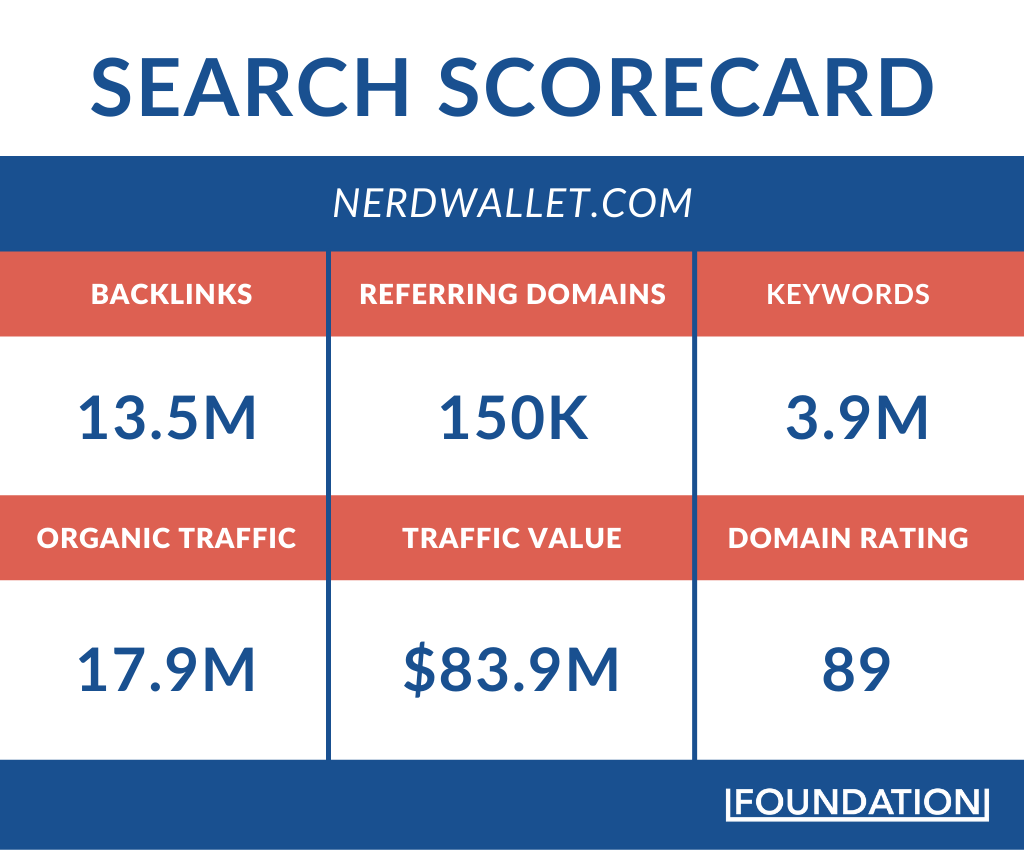
The truth is, B2B and B2C buyers are always looking for content that is relevant to their needs as they move down the funnel.
They want to know you understand their problem, and they need a reliable guide to lead the way, giving them the tools and tactics they need to solve the problem.
The SEO topic clusters strategy is a group of related, interlinked web pages around several broad topics that dive deep and offer different solutions to problems, based on your product offerings. It improves your site architecture and positions you as an authority in the eyes of prospects and search engines.
Topic clusters consist of three critical elements:
- A pillar page that covers all parts of the core topic
- Several cluster pages that dive deep into related sub-topics
- Internal links that connect all of these pages to each other
NerdWallet clustered their content pieces around nine topics relevant to the searcher’s intent. Yeah, you heard right. nine topics!
Here’s what NerdWallet’s topic clusters look like:
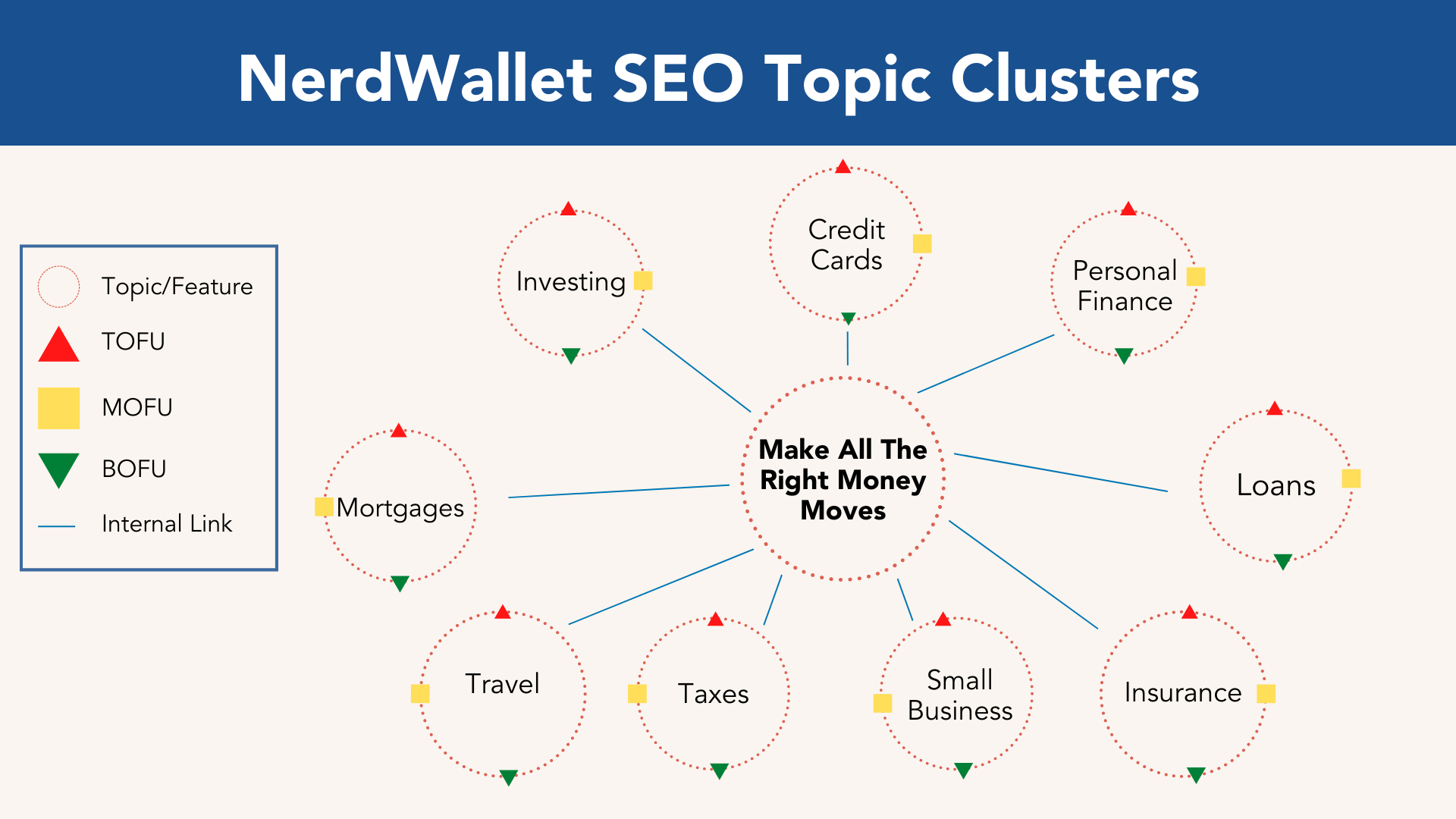
What’s brilliant about their topic clusters strategy is how it ties back to their value proposition as the go-to resource center for individuals and businesses looking to make the right money moves.
Each of these ten topics have pillar pages and related cluster pages that satisfy the searcher’s intent at every stage of the funnel and drive demand for the corresponding NerdWallet tool.
Take the credit cards topic, for example.
From the menu, you can see the topic broken down into the three sales funnel stages, including the pillar page.

That means a reader on NerdWallet’s home page or other parts of the website who hovers on the Guide and Tips menu can click on:
- Balance Transfer Basics: TOFU content for readers who are looking to learn the basics about the topic.
- How to Boost Your Approval Odds: MOFU content for readers looking for more specific solution-oriented content.
- Pick the Best Credit Card: BOFU content for readers who are comparing options and ready to make a decision.
- All about Credit Cards: The pillar page that links to related cluster content.
When you visit each of these pages, you’ll see how NerdWallet includes relevant information prospects would need to make a decision.
They include relevant CTAs, internal links, and they sometimes insert the tool in the article so readers can try the product before they sign up.
That means a prospect doesn’t even have to sign up before they use the product.
Prospects can read about and try the product, and possibly convert from a single piece of content. Talk about satisfying their needs and reducing the time a typical buyer would spend in the sales process.
What makes this strategy so effective is how they implement it at different stages of the funnel. Let’s see how NerdWallet uses the topic clusters to position itself at each stage of the sales funnel.
How NerdWallet Uses Topic Clusters at Each Sales Funnel Stage
NerdWallet’s topic clusters strategy helps the brand position itself as the go-to guide for investing, credit cards, loans, insurance, and six other topics.
They create content at every stage of the sales funnel to satisfy the searcher’s intent.
As we already know, there are three stages of the sales funnel, and each stage has different content pieces that attract, engage, and convert visitors to prospects to customers.
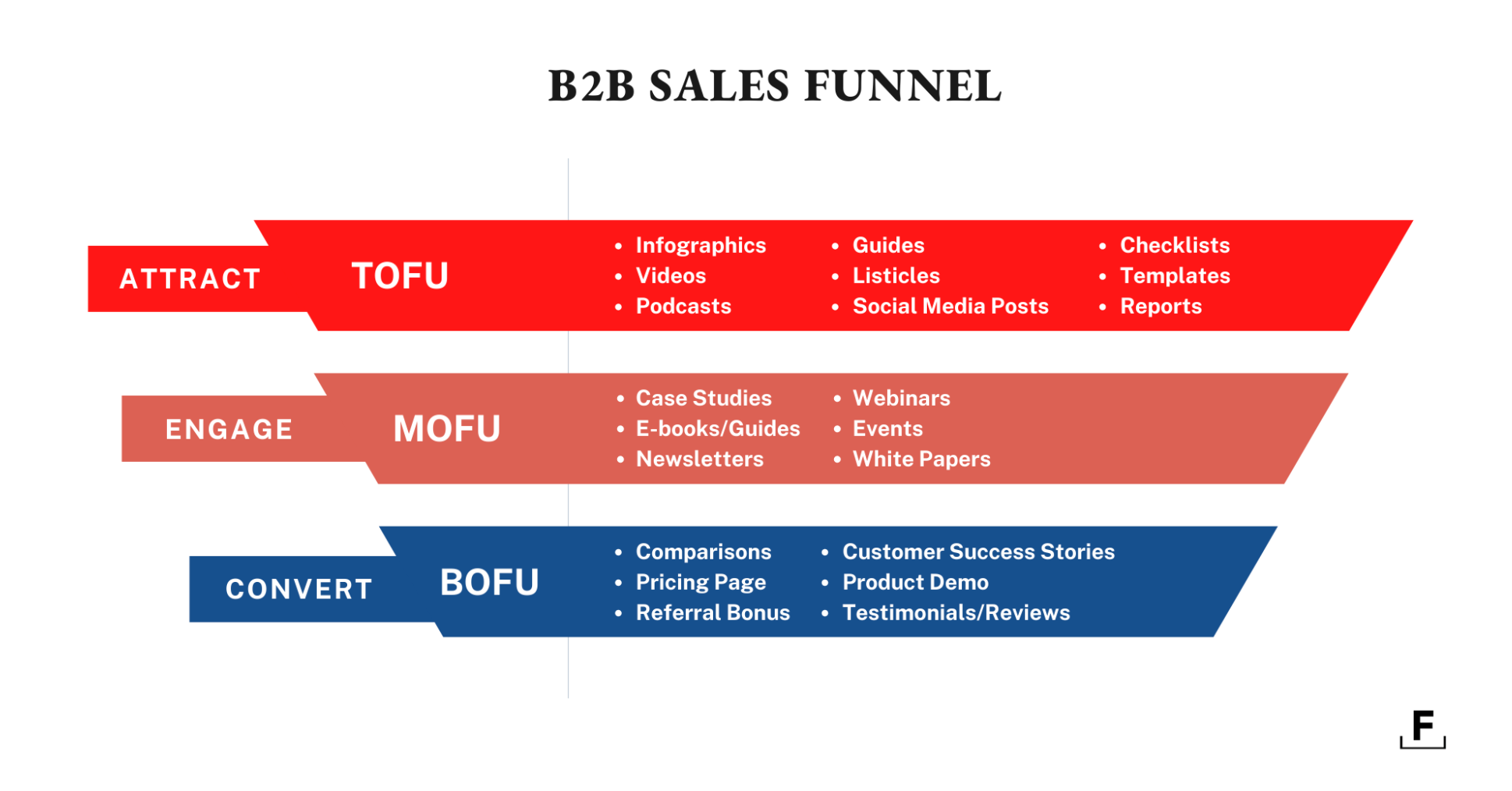
Let’s explore to see how NerdWallet uses topic clusters at each stage:
Top of the Funnel
The visual above shows the different content types that you can use at the top of the funnel to attract your target customers.
NerdWallet uses guides to attract their target customers for each topic cluster, and they dominate the SERPs for different top-of-the-funnel queries.
Take this query, for example: “fico score”, under the personal finance cluster. NerdWallet dominates the SERPs for this term, and the web page generates almost $300K in traffic value. Talk about treating content as an investment.
What I love most about this page is how it answers frequently asked FICO score questions:
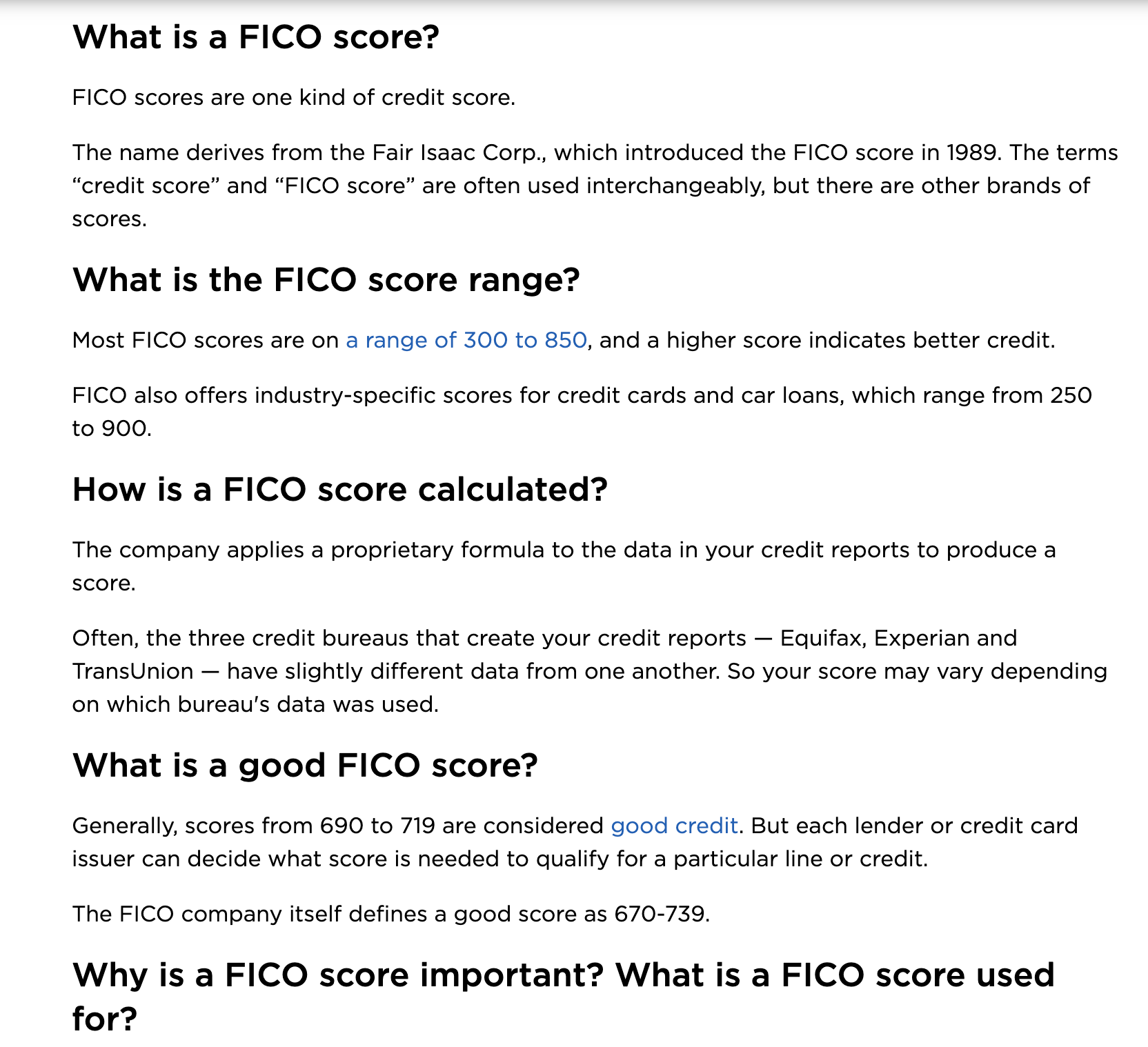
NerdWallet also cleverly plugs in this CTA after answering a couple of basic questions about FICO score so that people can make decisions after seeing its importance to their personal finance:

Anyone who clicks the CTA will land on a page where NerdWallet answers more questions, with strategically placed CTAs for the free tool around the page.

Another great thing about their TOFU pages is that one can choose to convert from that single content piece without having to read more, especially if they don’t need any more details apart from the answered FICO score questions.
The landing page’s linked CTA leads you to create an account straightaway:

Talk about converting a reader from a single content piece!
Middle of the Funnel
At the middle of the funnel, the prospect is considering several solutions to identify the best fit now that they better understand their problem.
NerdWallet nurtures leads using a variety of MOFU content types.
The company especially leverages detailed how-to guides that allow prospects to use the tools for free while they consume the content.
Like this blog post: Average American Net Worth by Age: How Does Yours Compare?

The blog post gives useful stats on all things net worth for US residents, and it also gives readers the free rein to calculate their net worth:
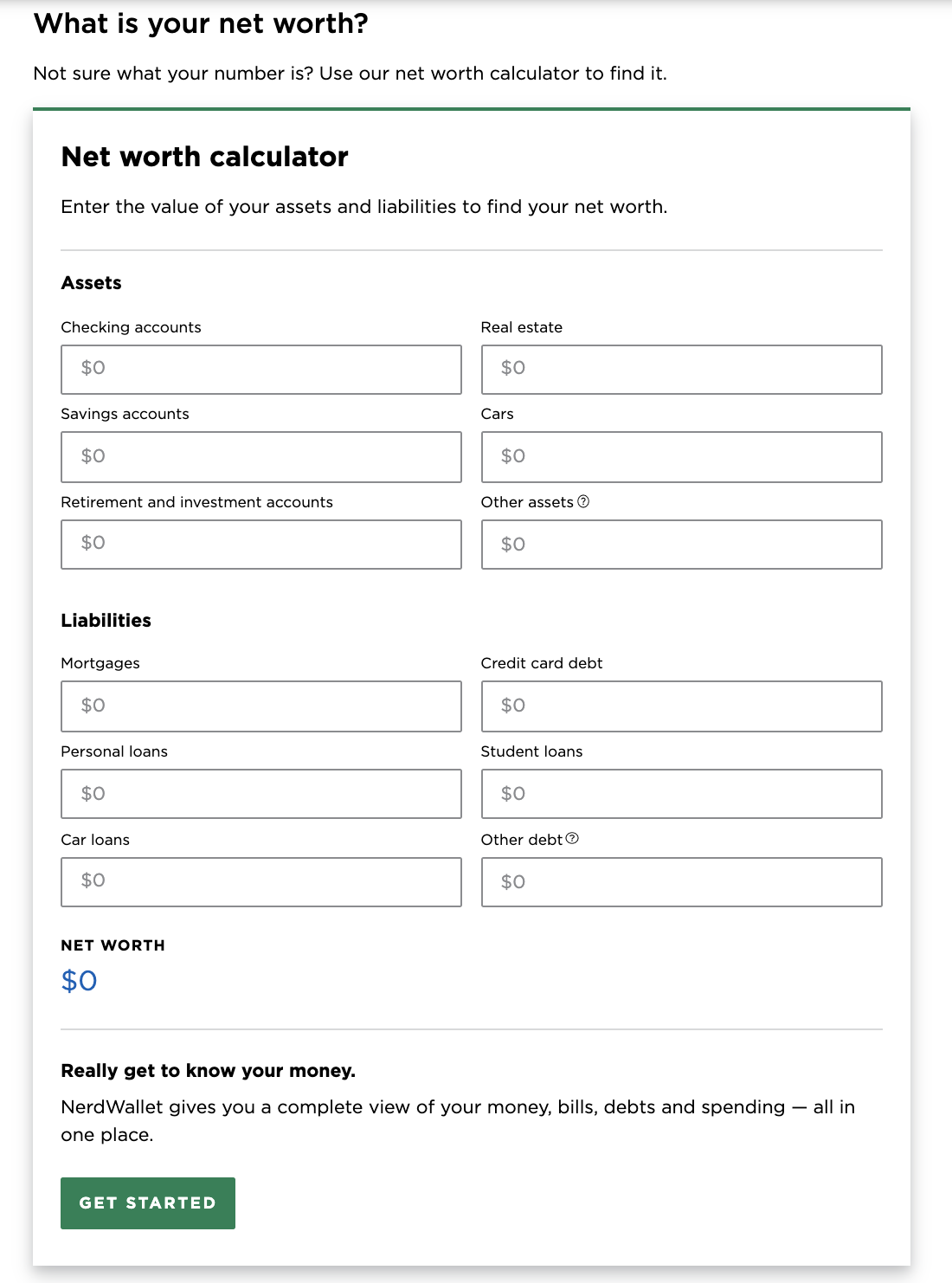
What better way to get prospects to trust NerdWallet than by offering them useful information about their personal finance, showing the product in action, and including a subtle CTA that tells prospects how they can use the tool to track and manage their finance? Impressive, I must say.
Little wonder the page attracts over 17K visitors every month, and it dominates the SERPs for the high volume keyword, “net worth by age”.
Bottom of the Funnel
At the bottom of the funnel, NerdWallet takes a completely different approach. They become the Yelp of Finance, like Capterra as the Yelp of B2B.
A good example is the cluster content 13 Best Cash Back Credit Cards of April 2022.
This BOFU content ranks number 1 in Google’s SERPs for the keyword “best cash back credit cards”, outranking authority sites like Forbes and Bankrate.
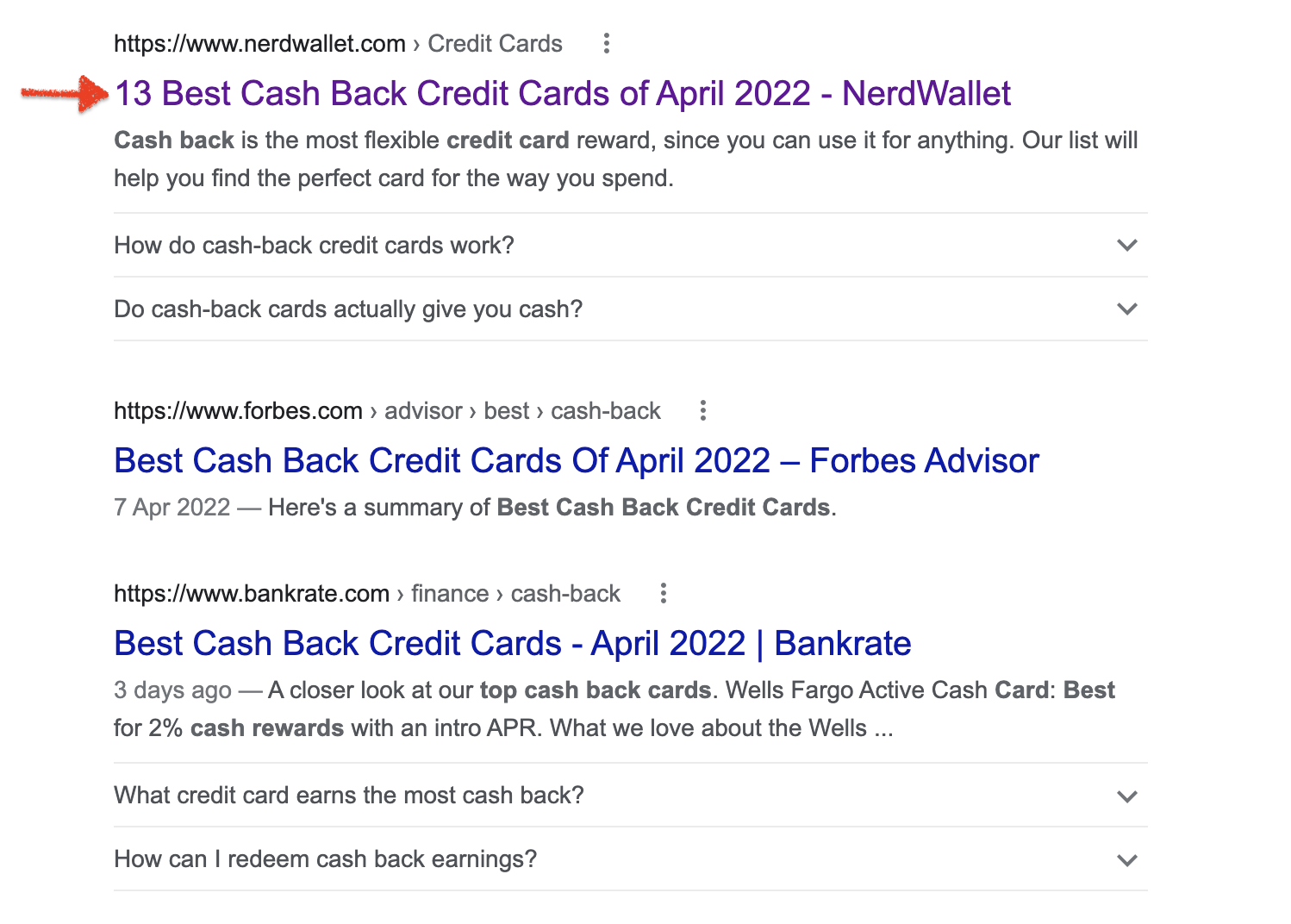
Over 32,000 people search for this term every month. The page is worth $1.2M in traffic value, with more than 79,000 people landing on this page every month.
What makes this page so great is its usefulness for someone in the decision stage. A person who wants the best credit card for themselves can easily navigate and make a choice, based on the format NerdWallet uses.
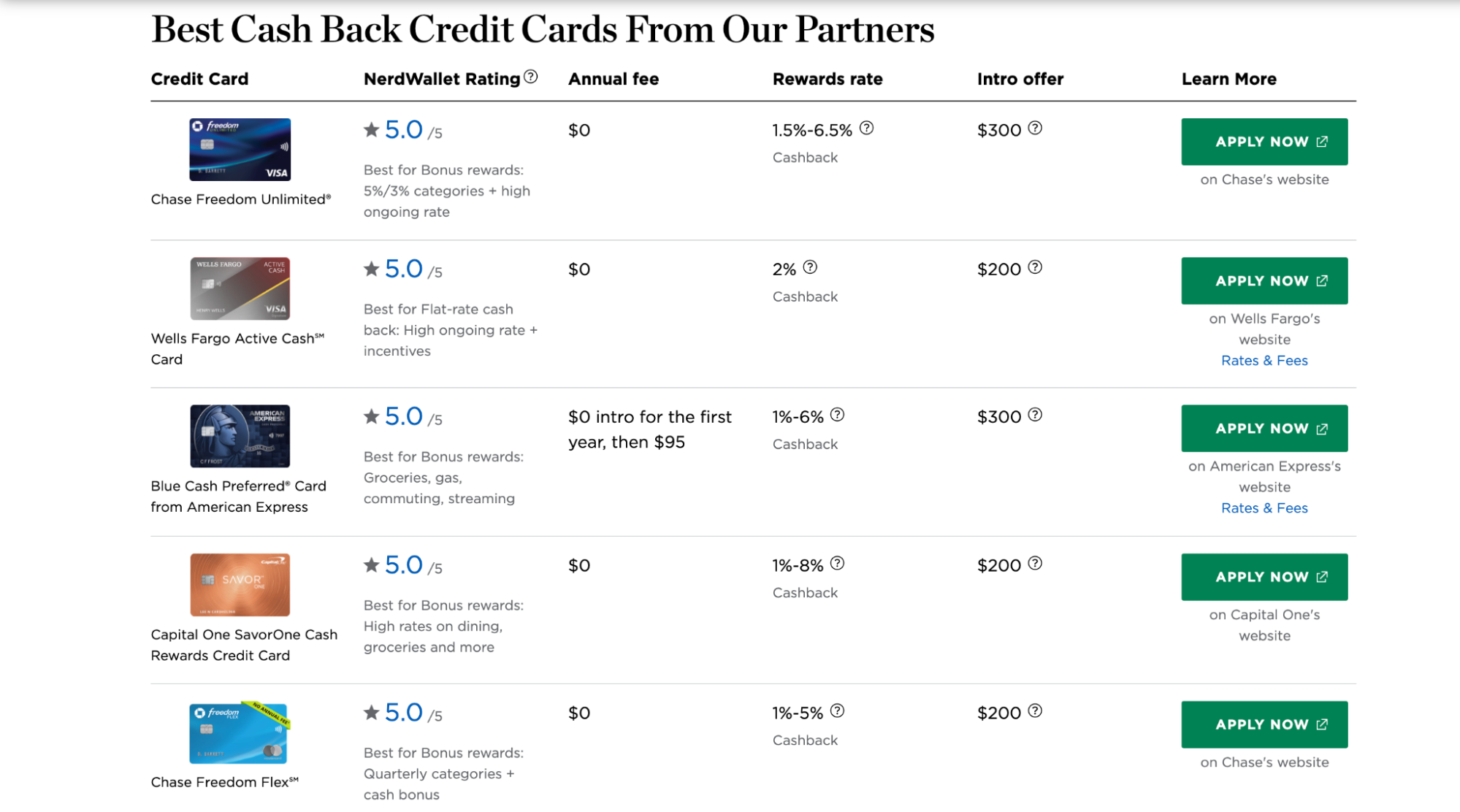
It’s like Capterra all over again, only in this case, NerdWallet positioned themselves as the Yelp of Finance with their super helpful BOFU content. Like Capterra, they also sort these cards into different categories to help readers choose the best fit for them.
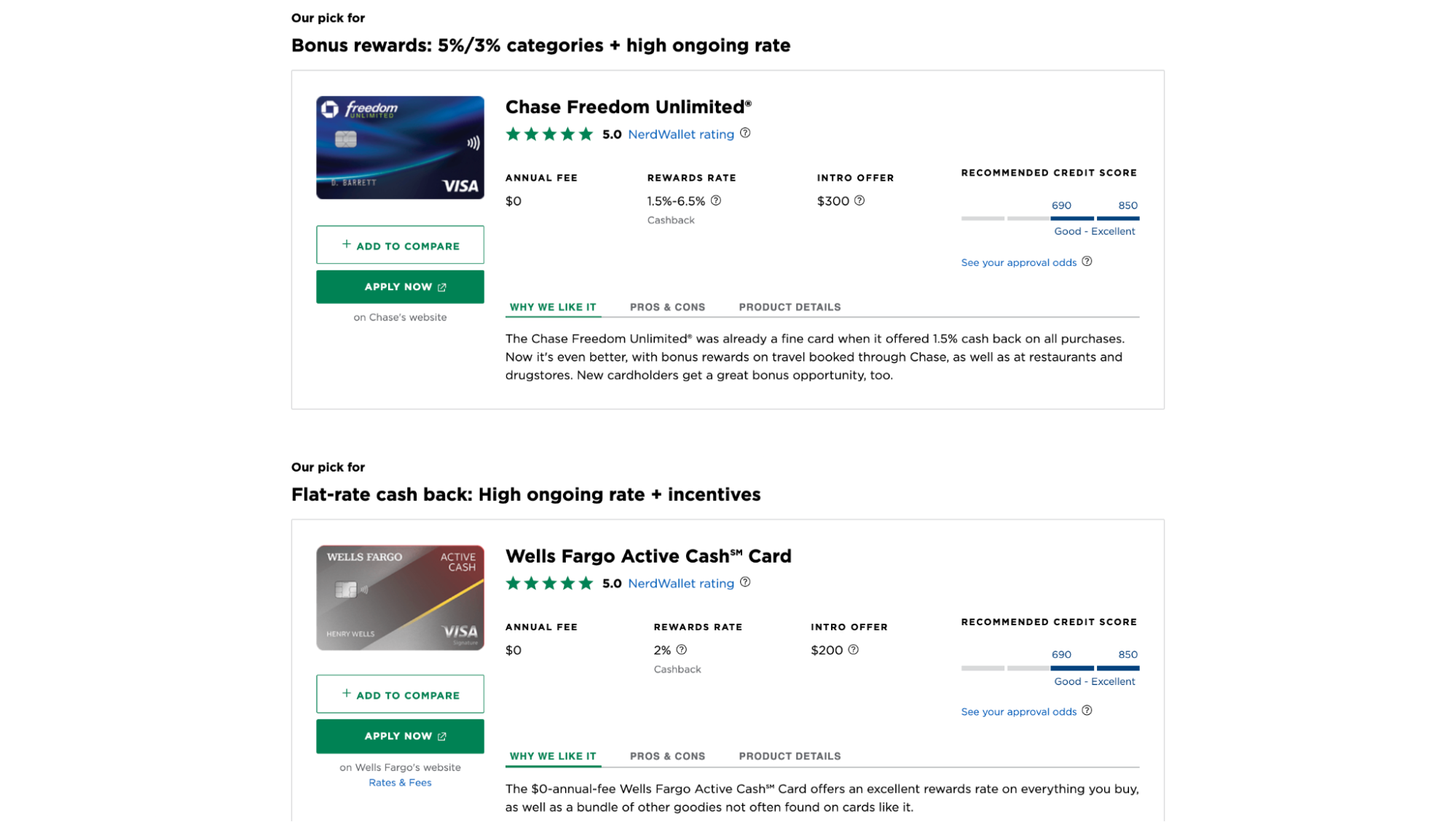
Credit card companies can leverage NerdWallet’s comparison pages as a part of their BOFU content mix, especially because people trust NerdWallet. And it’s a win-win for NerdWallet either way, as they operate an affiliate commission business model.
Overall, NerdWallet’s implementation of SEO topic clusters show that it’s possible to convert a user from a single or multiple related content pieces. That means a shorter sales cycle, lesser sales friction, and more conversions. All of these contributed to NerdWallet’s 600M+ valuation and over 39 million monthly users.
You should borrow and improve on their strategy if you want to generate qualified leads and close more deals.
Did I mention Google also favors the searcher’s intent?
That means the more relevant content you create around a topic, the better Google understands your site architecture, and the easier it will be for visitors and customers to navigate your site and find what they need.
How to Create SEO Topic Clusters For Your SaaS Company
Define Your Value Proposition
Finding the right keywords to define the value you offer customers is important.
From an organic search perspective, your value prop is a unique identifier that determines how Google identifies and presents you to potential customers. If you use the wrong keywords, you will attract the wrong audience for your business.
NerdWallet is all about the money, and they came up with a unique value proposition to reflect that. They use, “Make All The Right Money Moves.”

It may not be as niche as Hubspot’s, which is “Inbound Marketing, Sales, and Service Software”, or Foundation’s, which reads, “Content Marketing Agency For B2B Brands”. However, it works because it summarizes everything they do, especially because they serve both individuals and businesses. So, it’s ideal to go for a caption like this.
You should choose a value proposition that reflects your business’ core offering to the market. Answer the questions “What problem are we trying to solve, and what is the solution?” You want to choose a benefit-driven, optimized one-liner that reflects the solution you offer. You can even include who you serve, as we did.
Just choose what works best for your brand, and ensure your one-liner reflects your value proposition.
Choose Industry-Relevant Topics You Want to Be Known For
After defining the value you want to offer your customers, your next step is to choose topics you want to focus on.
NerdWallet focused on choosing topics around money. They identified their services and chose to target topics around these services.
Take a look at their menu. See how the tools section (calculators) and the guides and tips section align:
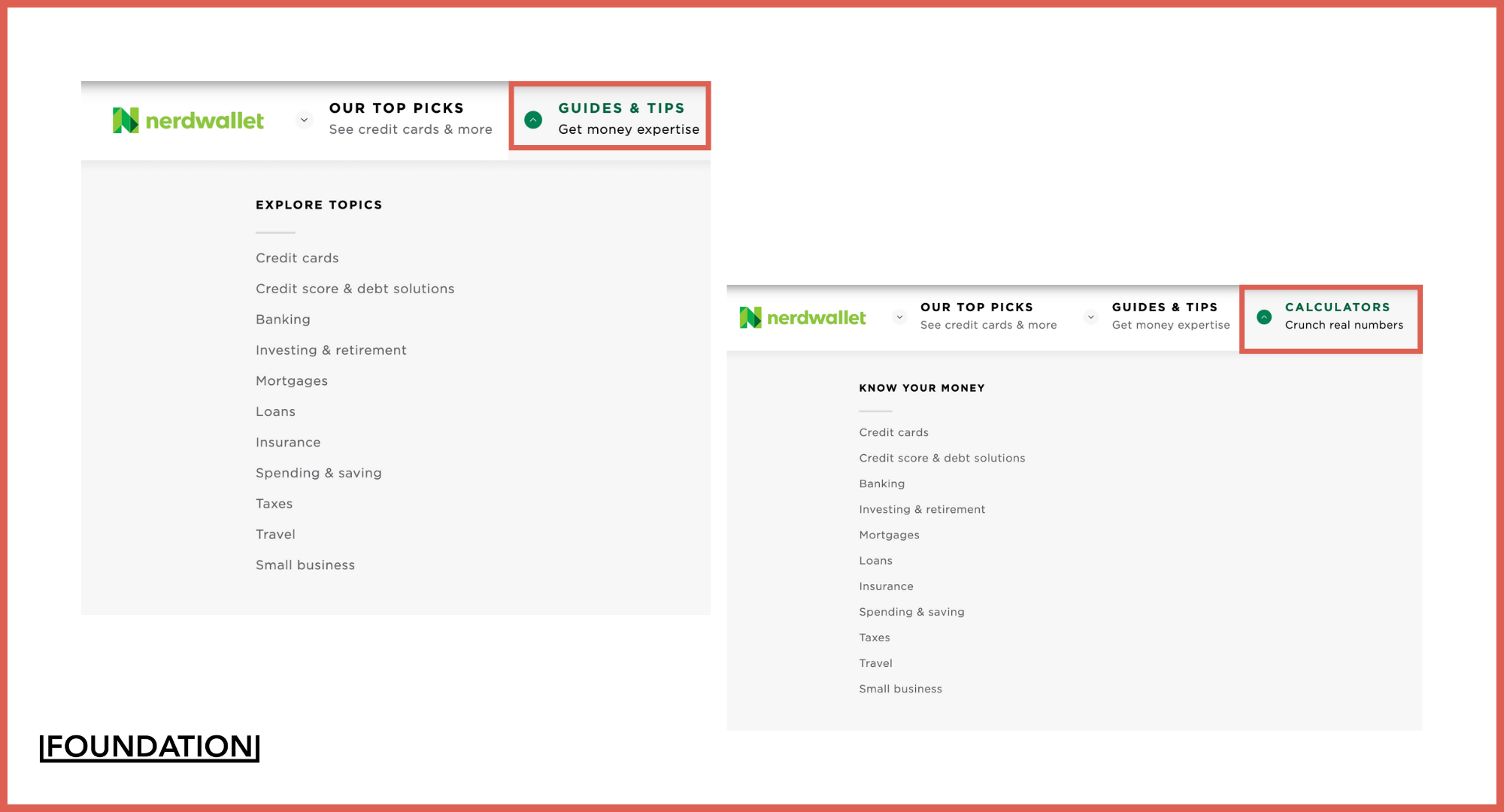
NerdWallet created topic clusters from their free tools and services, and they used the content to generate demand for their tools.
You can use tools like Ahrefs, Moz, SEMrush, and similar tools to see similar content themes your competitors are ranking for. That should give you a headstart.
Alternatively, you can come up with some topics on your own, and use any of these tools to do some keyword research to find the best keyword with good search volume you can use for each topic.
Also, NerdWallet has 10 topic clusters. You don’t have to start with 10. That’s overwhelming for a start. We recommend you start with 2-4, focusing on building authority one cluster at a time. That’s how you generate consistent demand.
Find Related Keywords & Search Queries For Each Sales Funnel Stage
After choosing the topics you want to be known for, you should generate queries for each of these topics.
NerdWallet, for example, generated a series of queries for each topic cluster.
Here are some from the personal finance category:
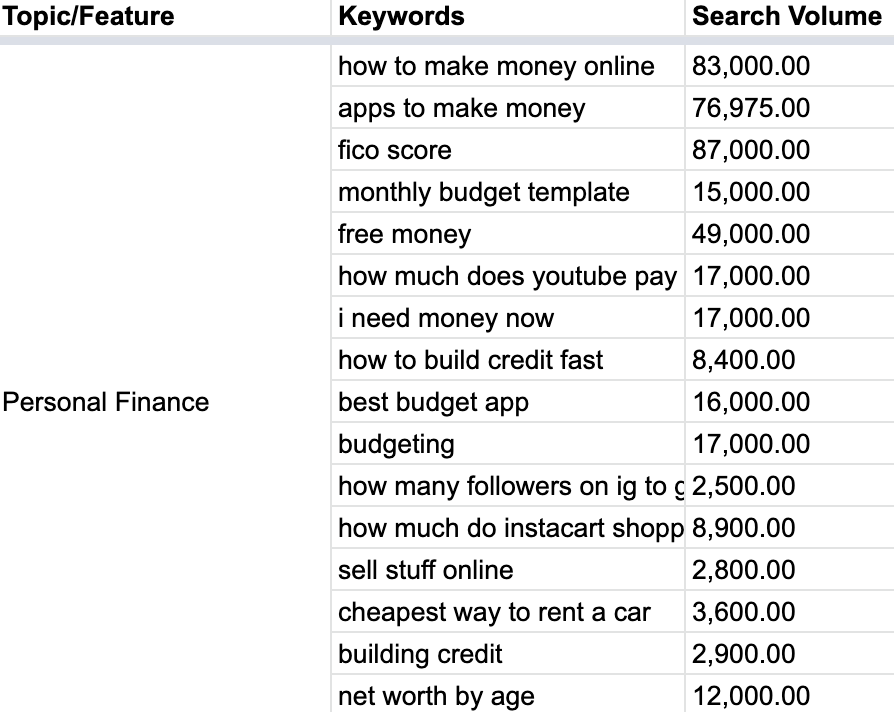
Notice how these keywords are long-tail.
Long-tail keywords are usually keywords with lesser search volume but higher search intent. That means the people who enter these keywords into the SERPs need specific answers, and they are more likely to convert when they get it than someone using generic search phrases.
I’m certain that when NerdWallet chose these keywords, they probably didn’t have as high traffic volume as they do right now. However, they are now worth something. Some of these keywords generate as high as $900K for the company:
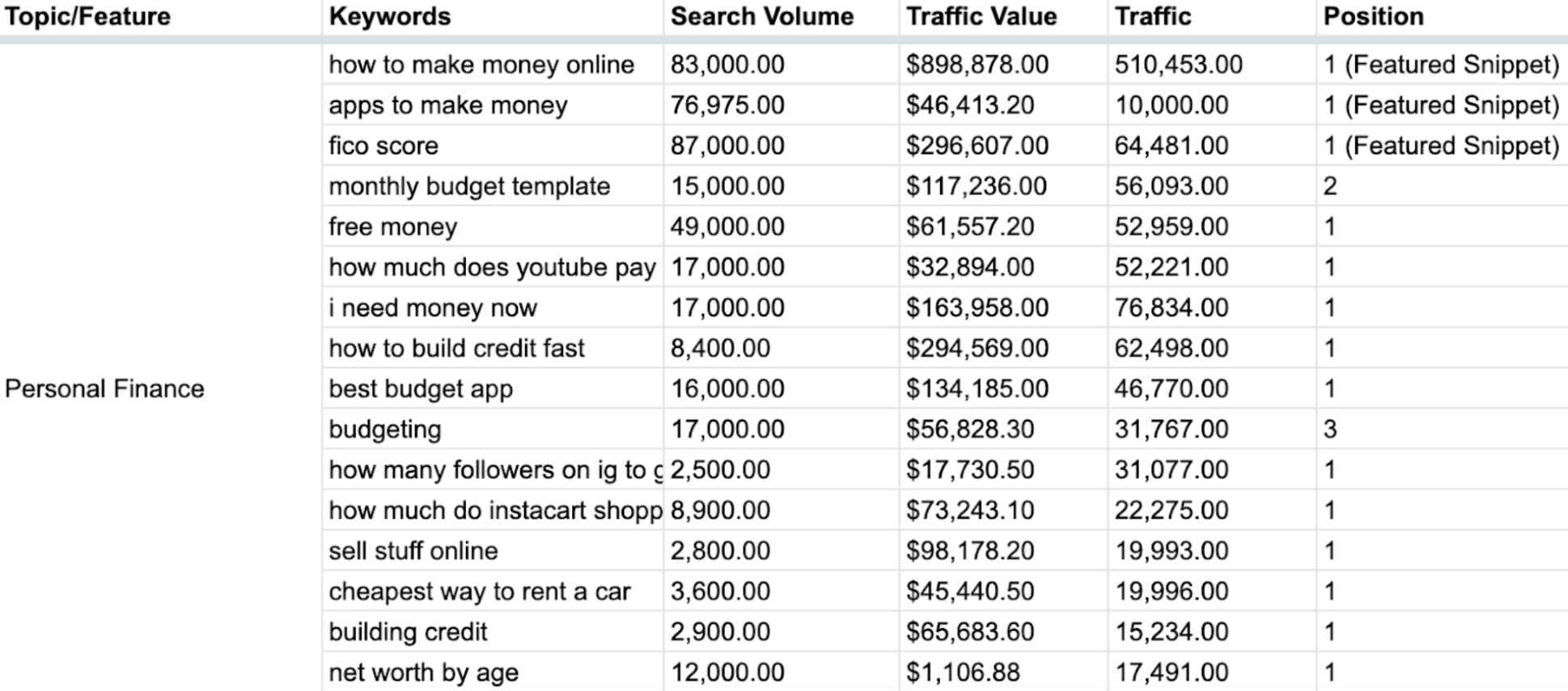
We recommend you find relevant, niche long-tail keywords and create in-depth engaging content around them. Then split these search terms into TOFU, MOFU, and BOFU queries. That way, you create content that educates, entertains, and engages customers at each stage of the sales funnel.
Create a Content Calendar to Execute
After doing the research, the next critical step you need to take is creating an execution plan. That’s where your content calendar comes in.
The content calendar is a simple plan that outlines the topic cluster you will be prioritizing in a month, and the queries you’ll be paying attention to that month.
Your content calendar can be the difference between 10 hours wasted on endless planning and 10 hours invested creating content that impacts your bottom line and positions you as an authority in the eye of prospects.
The best way to go about creating your content calendar is to start small.
Create a one-month calendar first. In that month, you can aim to create four high-quality blog posts, one of which will be the pillar page for your focus topic.
The pillar page is the piece of content that addresses all possible subtopics under that topic, in a way that is super relevant to users. It can be an ultimate guide on your blog or a downloadable ebook. Then you can schedule creating three other cluster content or subtopics under that topic, and link them to each other.
Of course, we know creating a content calendar is no easy feat. That’s why we are here to help you. You can use this one-month content calendar template to get started with planning your blog post and distribution with intent.
Wrap Up
Creating SEO topic clusters for your SaaS product will boost your authority and credibility in the eyes of your target audience and search engines.
Like NerdWallet, you stand a better chance with a more organized site structure than you do with some random blog posts here and there. You should keep in mind that any topic you choose to rank for has many different subtopics. So, it’s important you focus on a particular topic first.
Create how-to content, ultimate guides, comparison posts, and other content pieces relevant to your industry and customers for different stages of their journey. That’s how you win your audience’s trust and eventually their money and network.
Quick, do it now before the next drop!








